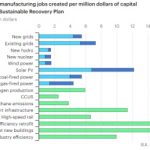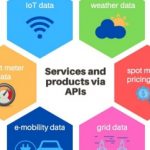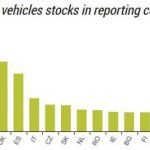Like many other sectors, the energy sector needs employees with digital skills. They need to create the new tools that can match power supply with demand, predict and detect faults in networks, and give greater control to consumers. It’s an essential part of the new world of decarbonisation, with digitalisation enabling the faster integration of renewables, improving grid stability and unlocking greater energy savings. Aloys Nghiem, Marc … [Read more...]
1,500GW of Renewables deployment delayed globally because Grids aren’t modernising fast enough
A first-of-its-kind global country-by-country study, “Electricity Grids and Secure Energy Transitions” by the IEA finds that electricity grids are not keeping pace with the rapid growth of clean energy technologies. Without greater policy attention and investment, shortfalls in the reach and quality of grid infrastructure puts at risk our climate goals. Worldwide, we need to add or replace 80m kms of power lines by 2040 – an amount equal to the … [Read more...]
IRENA’s Innovation Week 2023: Renewable solutions to decarbonise end-use sectors
At the end of September IRENA held a four-day event “Innovation Week 2023: Renewable solutions to decarbonise end-use sectors” in Bonn, Germany. A wide range of speakers discussed tangible solutions to decarbonise energy intensive sectors such as transportation, buildings and industry, informed by first-hand project experiences and supported by insights from IRENA’s in-depth analyses. Topics included direct and indirect electrification, green … [Read more...]
Europe’s grid bottlenecks are delaying its energy transition
***While you're here... REGISTER NOW for "REPowering the grid for Solar PV" with the Vice-President of Tauron, DG ENER C, Eurelectric and SolarPowerEurope - Online Wednesday September 20 from 11:00 to 12:15 CEST*** No amount of record sales and deployment in Europe of heat pumps, EVs, solar farms, wind turbines and all the rest will guarantee the region meeting its electrification targets if the grids aren’t ready to integrate them. As … [Read more...]
Decarbonising Shipping: “book and claim” pilot uses clean fuel tokens that move from cargo through to fuel producers
Switching to clean alternative fuels is the key component of the decarbonisation of shipping. But it faces the classic “chicken and egg” problem of who moves first: the fuel producers, the refuelling ports or their customers the ship and cargo owners. Aparajit Pandey and Oscar Hernandez at RMI explain how a “book and claim” system can be the answer. It’s already proven itself in electricity markets and the aviation sector. Digital tokens are … [Read more...]
Distribution Grid Digitalisation – benefits, policy, cost & funding
About a third of European grids are over 40 years old. A rapid physical overhaul would be impossible, so the addition of a layer of digital technologies is the key to preparing them for the distributed and intermittent generation from renewable sources, the increased electricity demand from transportation, heat pumps and other sectors, and for ensuring energy efficiency at all levels. It’s why the EC expects about €584bn of investment in Europe’s … [Read more...]
Event summary: “45% RES by 2030: EU’s latest investment challenge to DSOs”
Sara Stefanini provides a written summary of our panel discussion held on Thursday June 30th 2022. It’s a full summary of the 90 minute discussion (including audience questions), but it begins conveniently with a summary of the highlights. Investment in and the modernisation of the electricity distribution grid is one the biggest challenges the EU has to overcome in the next decade. It’s a €400bn investment challenge by 2050 says Eurelectric, an … [Read more...]
Manifesto: fit-for-purpose flexible grids for the clean electrification of Europe
The integration of new clean generation sources on top of the increase in electrification of industry, e-mobility, and heating and cooling means grid investment must be made a priority. Anything else will leave deployment-ready solutions waiting, slowing down the transition. The backdrop is that over one third of the EU’s grids are already more than 40 years old. Eurelectric has produced a manifesto, “Connecting The Dots”, that estimates … [Read more...]
District Heating Roundtable: Policy across RED, EED and EPBD “must take account of conditions in all Member States”
Sara Stefanini provides a written summary of our panel discussion held on 10th February: District Heating under the "Fit for 55" package: challenges and opportunities. Under the “Fit for 55” package, the EC proposed several regulatory changes that, combined, are meant to decarbonise district heating in Europe. But are these options workable for all? The participants raise questions over the support for district heating, whether the multiple … [Read more...]
Critical Raw Materials for the energy transition: Europe must start mining again
A ramp up of the supply of critical raw materials (CRMs) is essential for the world’s energy transition. Wind and solar, batteries, digitalisation, transport and hydrogen cannot meet their targets without it. The EU defines 30 minerals as critical. To give one example, the global deficits in lithium supplies could surge more than 60-fold to 950,000 tons by 2030. Frank Umbach at EUCERS takes a thorough look at the issue. Europe represented just 5% … [Read more...]
Distributed Energy Resources and Smart Grids: an opportunity or a distraction?
Distributed Energy Resources (DERs) are poorly understood by the utilities, explain Doyob Kim and Alyssa Fischer at the IEA. Part of the problem is that new innovations and solutions are coming fast, and policy-makers aren’t creating the incentives and frameworks to make them an imperative. But, done right, the successful integration of DERs into the grid will accelerate electrification, address grid stability, and reduce spending on expensive … [Read more...]
Energy efficiency is the “first fuel”, making decarbonisation easier for all other sectors
To set up our upcoming online event “China: Carbon Neutral by 2060 -EFFICIENCY FIRST” we look at the profound importance of efficiency to the global energy transition. Energy efficiency is the “first fuel”, meaning success here will make the decarbonisation of all the other sectors and technologies easier, faster and cheaper. Basically, use and waste less energy. Alyssa Fischer at the IEA starts by noting that their Sustainable Development … [Read more...]
Improving grid response to support climate targets and increased renewables [Energy Post event video]
We present our video of the online discussion from February 24, 2021 on smartgrid response. Digital, automated, data-driven smart response systems can play a key role in grid security and stability going forward. This makes asset monitoring and controllability - underpinned by the Smart Grid Indicator which is now part of the EU Electricity Directive (Article 59) - a vital link in the chain. Taking part were Vera Silva, COT, General Electric and … [Read more...]
A marketplace for energy data will enable Europe’s grid expansion
The growth of the decentralisation of energy generation and storage combined with the digitalisation of the metrics of supply and demand is pointing towards a marketplace for energy data, explain Veronika Spurná and Helena Uhde at the EU-China Energy Cooperation Platform. Such a marketplace will monetise the data itself, in recognition of its vital role in enabling the intelligent distribution of energy and investment. There will also be a place … [Read more...]
Clean Trucks are coming: a review of battery, hydrogen, synthetic fuels and more
New EU fuel efficiency rules are forcing truck makers into a race to get their low emission vehicles onto the roads. From 2025, newly registered trucks must have 15% lower emissions, and from 2030 it’s 30%. Battery-electric drivetrains are most likely to dominate, assisted in their evolution by the assured progress and charging infrastructure of EVs. Hydrogen fuel cells and synthetic fuels are also in the game, though hindered by the inevitable … [Read more...]
















